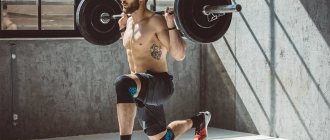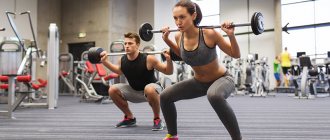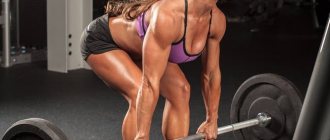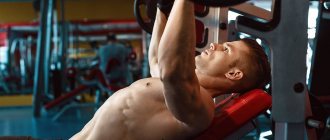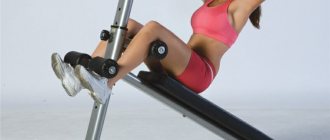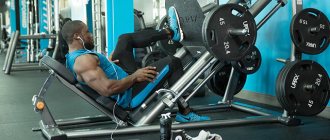The 7 shoulder training programs given in the article will help you figure out what exercises you can do to pump up your deltoids. Each set of shoulder exercises will help pump up the entire shoulder girdle and work out all the deltoid muscle bundles and separately, the middle, anterior and posterior ones.
- How to pump up your shoulders
- How to build big shoulders: training for mass Shoulder training program for mass
- Shoulder training for relief
- Training program
- A set of exercises for the middle deltoids
- A set of exercises for the rear deltoids
- A set of exercises for the front deltoids
How to pump up your shoulders
There are no two people who would train exactly the same way and build big shoulders. Each athlete performs a different sequence of exercises, number of approaches, uses different weights and length of rest periods. This article will help everyone figure out how to pump up their shoulders in the gym or at home.
Individuality is an inherent property of a person, and there is nothing wrong with that, but it imposes restrictions on how to pump up the deltoid muscles for an individual person. Certain principles and approaches make training better, especially when it comes to the question of how to quickly pump up your shoulders. Therefore, I have compiled 7 really effective sets of shoulder exercises, each of which will tell you how to pump your shoulders for relief, width and mass.
Please note that the order of exercises, weights, number of repetitions and volume can be changed to find the best way for you to pump up the deltoid muscles. Once you choose a workout that works for you, follow it for 4-8 weeks and then return to your usual routine or try another one from this list.
Notes:
- Below we will mainly talk about how to pump up your shoulders in the gym, but some of the programs are well suited for training at home.
- The given sets of exercises do not include warm-up. When warming up, perform as many reps as you need, but never reach muscle failure.
- Choose a weight that will allow you to reach muscle failure in the prescribed number of repetitions. This will be the correct pumping of the shoulders in order to involve the maximum number of delta muscle fibers in the work and achieve muscle growth.
- If you're training with a partner, do a few forced reps on your heaviest set of overhead presses. If not, then perform a drop set on the last set of each exercise, reducing the weight by about 25% when muscle failure is reached. In total it needs to be achieved 2 times.
The best shoulder exercises with dumbbells.
✅ Standing dumbbell press.
This is one of the most common and basic exercises, which includes the front and middle bundle of deltoid (shoulder) muscles, as well as triceps.
Stand with dumbbells slightly above shoulder level. As you exhale, press up, bringing the dumbbells together at the top point. As you inhale, return to the starting position.
Also, this exercise can be performed while sitting.
In this embodiment, you exclude the leg muscles from the work, and leave the entire main load on the shoulders. The technique is similar.
✅ Standing dumbbell swings
This is perhaps one of the most effective shoulder exercises with dumbbells.
Unlike all presses, when performing swings, the triceps are excluded from the work, and it is the middle shoulder delta, which is responsible for width, that works in isolation. If you want to pump up your shoulders with dumbbells, this exercise is a must-have in your training program.
Technique: stand up straight. Legs slightly bent at the knees. As you exhale, spread your arms to the sides, engaging the middle delta. As you inhale, return to the starting position. The arms are slightly bent at the elbows and raised approximately parallel to the floor. Don't raise your arms too high or pull your shoulders up. Otherwise, part of the load will be transferred to the trapezius muscle. Also, this exercise can be performed while sitting.
In this option, you will give an even more isolating load to the shoulder muscles and pump up their middle bundle. The technique is similar.
✅ Dumbbell row to the chin.
This is another exercise for the middle deltoid with dumbbells. And it will also turn it into work in isolation.
Technique: exhale, starting the movement from the elbow, lift the dumbbells to the level of the shoulder parallel to the floor. As you inhale, return to the starting position.
✅ Arnold press.
This exercise is named after Arnold Schwarzenegger, who successfully used it to train his shoulders. The movement includes the front and middle beams. And the same triceps.
The exercise is not common, as it distributes the load too much across different muscles. However, it is quite famous.
Technique: stand up straight, bend your elbows, and place the dumbbells in front of you. As you exhale, turning your hands, lift the dumbbells above your head, bringing them together at the top point. As you inhale, return to the starting position.
Like the previous exercises with dumbbells, it can be performed while sitting.
As in other cases, performing the exercise while sitting puts a more isolating load on the shoulders.
✅ Swing dumbbells in front of you.
This is an isolation shoulder exercise with dumbbells that works the front deltoid.
Stand up straight and pick up dumbbells. As you exhale, lift the dumbbells until your arms are parallel to the floor or slightly higher. As you inhale, return to the starting position. Please note that you do not need to lift the dumbbells too high. This will take the stress off the muscles at the top of the movement.
✅ Bent over dumbbell swings.
This exercise will engage the back of your shoulder (rear deltoid).
Execution technique: stand in a tilted position, and as you exhale, spread your arms to the sides. As you inhale, return to the starting position.
All exercises are suitable for both men and women, and can be performed both in the gym and at home.
How to build big shoulders: mass training
Goal: building up all the deltoids
The most effective method for pumping up your shoulders in the gym is to work with heavy weights, but you need to approach the training correctly so as not to get injured. To do this, you need to warm up well and follow the exercise technique.
To build shoulder mass, always start your workout with the most difficult exercises (in this case, overhead presses) that allow you to lift more weight. Then perform single-joint exercises on each of the three deltoids: anterior, middle, and posterior. This will set the stage for muscle building work as long as you maintain your overall training volume.
When we pump our shoulders, we can complicate the training in several ways. For the overhead press, start by using dumbbells, which are notoriously more difficult to balance and allow for a greater range of motion than a barbell. You'll also do the reverse pyramid because it gives you the opportunity to do more sets with muscle failure. For the first 2 sets, you'll use fairly heavy weights in a low rep range (6) to build strength. As fatigue accumulates in subsequent approaches, reduce the weight by about 5 kg. Perform the last 2 heaviest approaches with a belay partner so that you can maintain technique.
Because the front delts do a lot of the work in chest training, and the middle delts bear the brunt of the weight during the overhead press, the rear delts often remain small and weak. In this workout, shoulder pumping takes place when you have a lot of strength in reserve. At the same time, don't be afraid to change the order of single-joint exercises based on your weaknesses. If you think that all of your deltoids are proportionally developed, simply perform these exercises in a different order at each workout.
Massive shoulder training program
- Dumbbell overhead press - 4 sets of 6,6,8,10 reps (2 minutes rest)
- Barbell rows to the chin - 3 sets of 8,8,10 reps (2 minutes rest)
- Bent-over dumbbell raises - 3 sets of 8, 10, 12 reps (1 minute rest)
- Standing dumbbell lateral raises - 3 sets of 8,10,12 reps (1 minute rest)
- Lifting the barbell overhead with straight arms - 3 sets of 8,10,12 reps (1 minute rest)
List of effective shoulder exercises
Standing barbell press
The main exercise for working the shoulder muscles. The main emphasis in it is on the middle delta bundle. However, pumping of this area occurs with the active participation of both the anterior and posterior bundles.
Initial position:
- stand straight, spread your feet shoulder-width apart;
- Take the projectile with a direct grip and lift it to chest level;
Performance:
- lift the projectile, exhaling at the end point;
- take a break;
- slowly, inhaling, lower the barbell to its original position, that is, to chest level.
General recommendations:
- no need to take maximum weight;
- your back should be slightly arched;
- You can use dumbbells as an apparatus.
Bench Press
A basic exercise that is entirely aimed at pumping up the muscles of the shoulder girdle. Unlike the previous one, it is performed from a sitting position.
Initial position:
- sit on a sports bench;
- arch your back a little;
- take the projectile with a wide grip.
Performance:
- simultaneously with exhalation, lift the barbell, while fully straightening your arms;
- while inhaling, lower the projectile behind your head.
General recommendations:
- The bench press must be performed smoothly, slowly, without jerking;
- The exercise can be diversified by alternating lowering the projectile behind the head and towards the chest.
Dumbbell press
Ideal training for pumping up the deltoid muscle at home. It is not only effective, but also accessible, since it is performed not with a barbell, which not every athlete has at home, but with dumbbells. Exercises using this sports equipment are great for those who, for some reason, do not have the opportunity to work out in the gym, but want to pump up their shoulders.
The training really works and allows you to achieve the desired result. The main thing is to be ready to give your best, be patient, and show diligence. Perseverance should be demonstrated not by the number of approaches, but by regular exercise. Otherwise, no significant effect will be achieved.
Initial position:
- sitting on a bench with a back, keep your back straight and straight;
- the chin should be parallel to the floor, the gaze should be straight;
- keep the projectiles at eye level;
- Extend your elbows, but make sure they are under your hands.
Performance:
- exhaling, squeeze the shells up;
- Without turning your hands, bring the dumbbells together at the top point;
- hold for a few seconds;
- inhaling, smoothly return to the original position.
General recommendations:
- hands must be moved in the same plane;
- to avoid adverse effects on the elbow joints, sharp straightening of the arms at the extreme point should not be allowed;
- It is strongly recommended not to bend back or bend your back.
Arnold press
This exercise has already become a classic in bodybuilding. Its effectiveness is beyond doubt. As is already clear from the name, this training was part of the mandatory training of Arnold Schwarzenegger, absolutely anyone, even those far from the world of sports, knows about his success in building a sculpted and beautiful body.
Initial position:
- sit on the bench, press your back to the back;
- bend your knees so that they form a right angle;
- spread your legs wide, place your feet as far as possible on the floor;
- lift the dumbbells to neck level;
- Bend your elbows at an angle of 90 degrees, turn your palms towards you.
Performance:
- exhaling, squeeze the shells vertically upward, turning your hands outward with your palms;
- make sure that your palms are facing forward at the extreme point;
- stay late;
- take a breath, return the projectiles smoothly to the starting position.
General recommendations:
- It is better to perform training with lighter dumbbells than for other exercises;
- The elbows at the extreme point should be left slightly bent, and not straightened to the end;
- The press must be performed straight, preferably without stopping in the lower position;
- In order not to have an additional impact on the spine, acceleration and jerking should be avoided.
Lateral dumbbell raises
Another exercise that is great to do at home. The training is isolating. It is aimed at working out and pumping up the side of the delta.
Initial position:
- stand up, lean forward slightly;
- lower your arms with the dumbbells down.
Performance:
- take a deep breath, spread your arms shoulder-width apart;
- the back of the dumbbells at the most extreme point is slightly raised;
- exhaling, gently lower your arms to their original position.
General recommendations:
- Cheating is unacceptable;
- the entire load should be concentrated on the shoulders.
If there is cheating during the training, a completely different muscle group is involved. This reduces the result.
Bent-over dumbbell raises
Aimed at working out the back of the muscles of the shoulder girdle.
Initial position:
- standing straight with dumbbells in your hands, lean your body forward at an acute angle;
- lower your hands down.
Performance:
- taking a deep breath, spread the shells to the sides, raising them to the maximum possible height;
- As you exhale, return your hands to their original position.
Recommendations:
- at the extreme point of lifting, the front part of the projectile should be slightly tilted forward;
- You need to keep your back straight, but bend a little at the lower back;
- You cannot round your back, as this can lead to injury.
Raising the barbell to the chin
Basic training, which is more aimed at working out the middle deltoids, but also pumps up the trapezius muscles.
Initial position:
- standing straight, grab the barbell with an overhand grip, holding it down;
- The distance between the palms should be about two fists.
Performance:
- exhaling, lift the projectile to your chin;
- hold the barbell in the most extreme position;
- take a breath, return to the starting position.
Recommendations:
- elbows should be constantly apart and rise strictly vertically;
- You cannot bend your neck and back, your chin should be horizontal;
- when lifting the barbell to the chin, the bar must be raised above shoulder level;
- the weight of the apparatus should not become an obstacle to the correct execution of the exercise.
How to build sculpted shoulders
Goal: definition of deltas
Here you will learn a good way to pump up deltoids by drawing individual fibers. Lifting light weights for high reps is no longer considered the best way to achieve delt definition. First and foremost, this indoor shoulder workout aims to stimulate muscle growth (moderate weights in a moderate rep range). To increase the number of calories burned during and after training (post-exercise oxygen consumption effect), high volume is used in combination with supersets. Here you will move faster and feel a real burning sensation in your muscles. Now you know how to pump up your muscles so that they are not only sculpted, but also the so-called “cut” appears.
Shoulder training for relief
- Seated military press - 4 sets of 8-12 reps (2 minutes rest)
- Standing Dumbbell Raises - Superset: 3 sets of 10-12 reps (no rest)
- Bent-over dumbbell raises - 3 sets of 10-12 reps (60-90 seconds rest)
- Raising your arm in front of you in a crossover - 3 sets of 10-12 repetitions (without rest)
- Crossover Chin Row - 3 sets of 10-12 reps (60-90 seconds rest)
- Butterfly raises - 3 sets of 10-12 repetitions (without rest)
- Raises of arms to the sides with an expander - 3 sets of 10-12 repetitions (60-90 seconds for rest)
Terrain training
As with most relief exercises, you need to do it with light weights - a lot and at a fast pace.
Such loads not only pump up muscles, but also burn fat at the same time, which allows you to more clearly “draw” each muscle.
However, when training for deltoids, there are nuances: you need to perform several supersets with a large mass so that each muscle bundle is worked out.
Otherwise, no amount of drying can help - the shoulders will simply resemble a solid round ball, unnaturally attached to the bones.
It is necessary to alternate long-term loads with light weights and short periods of weight lifting so that a “cut” is observed - the separation of each muscle from the total as a result of pumping all sections of the delta.
In another article we told you how to remove your belly and sides.
Program
Relief training includes a variety of exercises.
Here are just the main ones:
- Arnold Seated Press – 4 sets of 10 reps.
- Dumbbell lateral raises – 3 sets of 20 reps.
- Bent-over dumbbell raises – 3 sets of 20 reps.
- Lifting the barbell to the chin - 3 sets of 10 times.
- Exercise on a special “butterfly” simulator for the rear delts – 3 sets of 15 times.
- Raising arms to the sides with an expander – 3 sets of 15-18 times.
The butterfly exercise machine is a rather rare piece of equipment, so it is not available in all gyms.
If it is absent, you can perform additional sets of lifting the barbell to the chin.
See also: How to remove thighs.
How to quickly pump up your shoulders
Goal: mastering the technique and providing a solid foundation for further training.
This complex consists of overhead presses and single-joint exercises for each deltoids. Start with a machine to learn the movements before moving on to free weights, which are best for building muscle.
Start with a light load and focus on proper technique. Add weight only when you can fully control the movement.
Training program
- Machine Overhead Press - 3 sets of 12 reps (60-90 seconds rest)
- Standing Dumbbell Raises - 3 sets of 12 reps (60-90 seconds rest)
- Crossover Front Raise - 3 sets of 12 reps (60-90 seconds rest)
- Butterfly raises - 3 sets of 12 reps (60-90 seconds rest)
Training for quick results
Every beginner is interested in the question of how long it takes to pump up your shoulders. It will take at least three months.
Fast pumping involves simultaneous load on all three deltas, so the workout contains relatively few elements.
In this case, you can quickly get your shoulders into shape, but you should not expect the appearance of an impressive relief or large mass.
Program for quick results
Most often, the express pumping scheme includes basic simple exercises that do not require a certain level of skill to perform.
This program includes:
- Exercise on the “butterfly” simulator – 3 sets of 12-15 reps.
- Dumbbell overhead press – 3 sets of 12 reps.
- Standing dumbbell lateral raises – 3 sets of 12-15 reps.
The technique for performing these exercises will be described in detail in the sections devoted to pumping each section of the deltoid muscle.
How to pump up your middle deltoids
Goal: building up the middle deltoid muscles To make your shoulders wider, you need to develop the middle deltoid muscles. This will also allow the waist to appear narrower and give rise to a wider shoulder girdle. The emphasis in this program, naturally, is on exercises for the middle deltas.
You will perform them at the beginning of the workout, when energy is at its highest level. You can alternate this program with a more balanced delt workout (like mass) during your weekly split.
A set of exercises for the middle deltoids
- Seated overhead press - 4 sets of 8 reps (2 minutes rest)
- Barbell Chin Row - 3 sets of 8-10 reps (60-90 seconds rest)
- One-arm dumbbell lateral raises - 3 sets of 10 reps (60-90 seconds rest)
- Standing dumbbell lateral raises - 3 sets of 10-12 reps (60-90 seconds rest)
Deltoid muscles: their structure and functions
Anterior deltoid muscle
- Function: Flexion, Mid Muscle Rotation
- Location : Front of the shoulder girdle
- Exercises: Barbell Press
Middle deltoid muscle
- Function: Muscle Abduction
- Location : Center side of shoulder
- Exercise: Dumbbell Lateral Press
Posterior deltoid muscle
- Function: Extension, lateral rotation of muscles
- Location : Back of shoulder
- Exercise: Dumbbell press with head resting on bench
How to pump up your rear delts
Goal: building up the posterior deltoid muscles
The posterior deltoid muscles often lag not only in beginners, but also in advanced bodybuilders. Simply put, they don't get as much stimulation as the front and middle deltoids, which are involved in chest exercises and shoulder presses.
To develop your rear delts, perform this routine for 4-8 weeks, or alternate it with a more balanced shoulder workout.
A set of exercises for the rear deltoids
- Overhead Press – 4 sets of 8-10 reps (2 minutes rest)
- Bent-over dumbbell raises - 4 sets of 8 reps (60-90 seconds rest)
- Crossover raises - 3 sets of 10 reps (60-90 seconds rest)
- Butterfly raises - 3 sets of 10-12 reps (60-90 seconds rest)
Shoulder training for mass - Base for muscle gain
These basic exercises are based on two multi-joint movements. The standing press is more challenging because it involves the whole body. Bringing the bar toward the front of your head raises your elbows slightly, so the press effectively targets the front and middle deltoids. If you have shoulder problems, don't lower the bar behind your head.
The seated dumbbell press allows your elbows to run straight along your body, effectively targeting the middle bun, which gives you visual width. This is where the rep interval begins to shift slightly (lighter weights), which provides a different training stimulus than the first exercise.
The last two movements are single-joint in nature, which translates into higher rep schemes. One is aimed at working the anterior beam, the other - the posterior, completing a balanced workout of all three heads of the shoulder. Remember that you followed the reverse pyramid principle and your first exercise was aimed at the lower range of hypertrophy (reaching failure at 6-8 reps) for a slightly stronger stimulus. This shoulder mass training program is a reverse pyramid and will allow you to perform more complete sets for maximum muscle loading. Pumping shoulders to mass begins with this program.
Shoulder Workout 1 – General
1. Military press
- 2 sets of 6-8 reps
- 2 sets of 8-10 reps
2. Seated dumbbell press
- 2 sets of 8 reps
- 2 sets of 12 reps
3. Raising two dumbbells in front of you
- 2 sets of 8-10 reps
- 1 set of 10-12 reps
4. Raising dumbbells to the sides while sitting with the body tilted
- 2 reps of 8-10 reps
- 1 set of 10-12 reps
How to pump up your front delts
Goal: Build Up Your Front Deltoids
If you train your chest frequently, you probably already have well-developed front deltoids. After all, they are involved in all pressing exercises, especially when performing them in an incline position. However, relatively weak anterior deltoids can hinder the process of building up the pectoral muscles. This training is designed to correct this situation.
There should be at least 48 hours between chest and shoulder workouts to allow the muscles to fully recover.
A set of exercises for the front deltoids
- Seated overhead press - 4 sets of 8-12 reps (2 minutes rest)
- Arnold Press - 4 sets of 8-10 reps (2 minutes rest)
- Front dumbbell raises - 3 sets of 10 reps (60-90 seconds rest)
- Crossover arm raise - 3 sets of 10-12 reps (60-90 seconds rest)
Number of approaches for shoulder training
You can see from the shoulder anatomy above that it is actually made up of 3 different small muscle groups. Many beginners treat the shoulder as one muscle group and train it like the chest: press, press, and press more.
The only problem with this training approach is that most of the shoulder mass will be gained in the anterior fascicle (front) and some mass in the middle and posterior fascicle (back) of the shoulder complex. This will cause terrible imbalance and can also lead to injury.
Without working on the middle and posterior deltoid muscles, the shoulders look narrow from all sides. Many times injury is the result of an imbalance such as this. Overall, the shoulder is a moderate-sized muscle, made up of three small muscles. Each muscle should receive the appropriate workload and nothing more.
The shoulder girdle can rotate almost 360 degrees and exercises will be performed in many different angles using weight machines, machines and cables. I like to use low reps (4-6) for compound pressing exercises and moderate reps (8-12) for isolation exercises.
All exercises must be performed with correct technique, because poor technique or bad exercise habits that you start now will follow you and lead to lack of progress or worse injury in the future. Many, if not all, of the exercises below will be new to you.
Now that you understand what muscles the shoulder is made of, its function, its location, and the number of sets required to strengthen them, let's give you some workouts that will help you build up your shoulders.
What to do if your shoulders don't grow
Goal: Pre-exhaustion of the delts
The triceps can sometimes be the limiting factor in shoulder training, especially in the press. If these muscles always give out before you've properly worked your shoulders, you'll never be able to push your delts to muscle failure and build your shoulders in compound exercises. The practice of pre-exhaustion is designed to correct this situation. This is the best way to properly pump up a lagging muscle. Here you first fatigue the delts with single-joint exercises and then perform overhead presses while the triceps are full. Thus, the deltoids must reach failure before the triceps do.
At the beginning of your workout, do not be tempted to go heavy with weights, as this will put additional stress on your elbow joints. Also, if you feel very tired by the time you get to the compound exercise, do it in a machine. It will be a little safer this way.
Training program
- One-arm lat pulldown - 4 sets of 8-10 reps (60-90 seconds rest)
- Lifting the barbell in front of you with outstretched arms - 3 sets of 10 reps (60-90 seconds rest)
- Butterfly raises - 3 sets of 10 reps (60-90 seconds rest)
- Machine overhead press - 3 sets of 8-10 reps (2 minutes rest)
- Barbell rows to the chin - 3 sets of 10-12 reps (2 minutes rest)
Source: https://www.bodybuilding.com/content/shoulder-workouts-for-men-the-7-best-routines-for-bigger-delts.html
Recommendations for training shoulders with a barbell
The effectiveness of the training depends on adherence to the fundamental principles. Let's list them:
- Multi-joint basic exercises should form the “backbone” of classes. It is these loads that form the spherical volume of the deltoid muscles.
- To effectively work your shoulders with a barbell, it is better to set aside a separate training day. This will allow you to focus on the target muscles.
- The program should be designed so as to involve all three heads of the deltas. Uniform proportional loads give excellent visual results.
- The deltoids need to be trained with serious weights. Choose such a load that the last two repetitions of the set are given with great difficulty.
- To make the deltoids grow, you need to perform a certain amount of training: 1 workout with a barbell per week, 4-6 exercises of 3-4 sets of 8-12 repetitions each.

